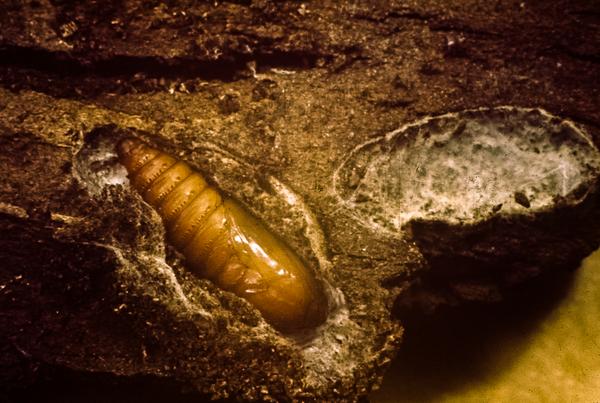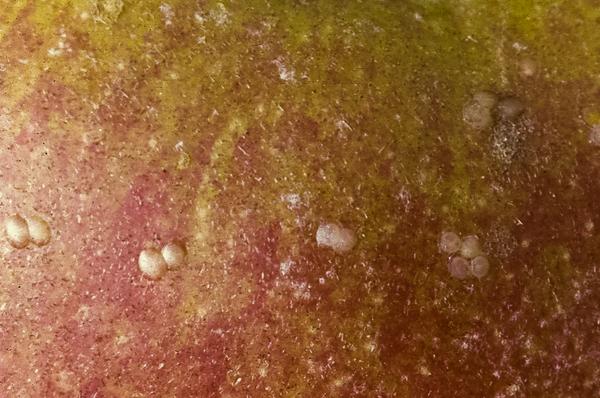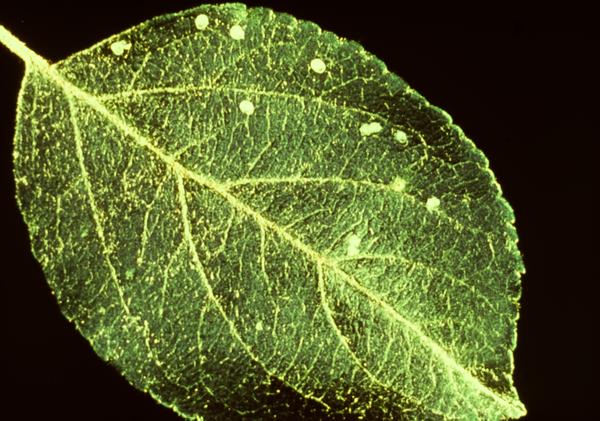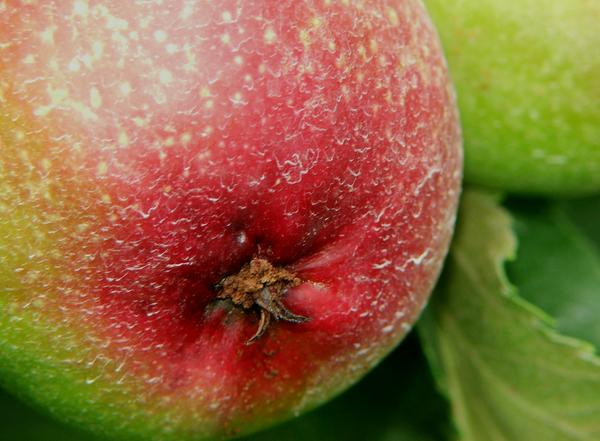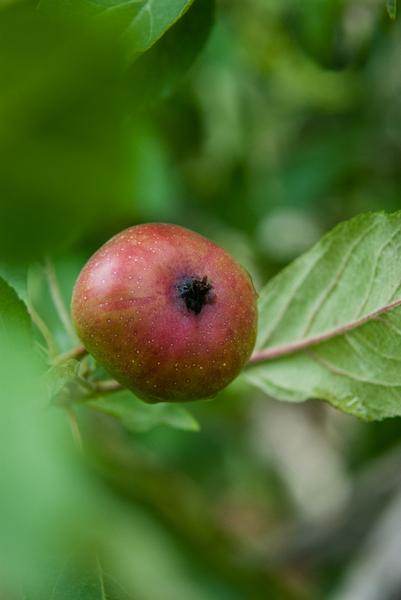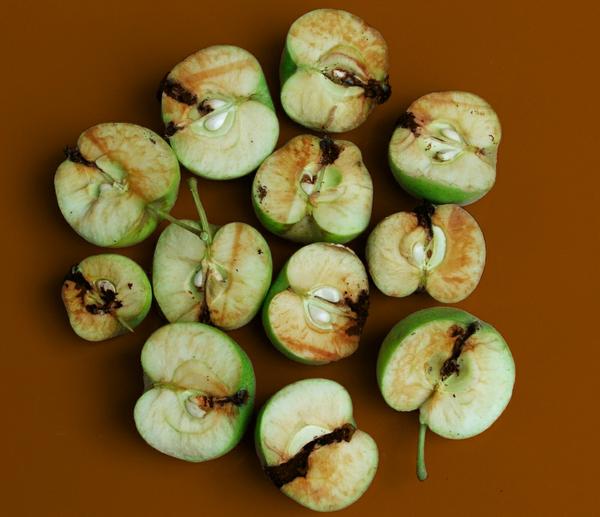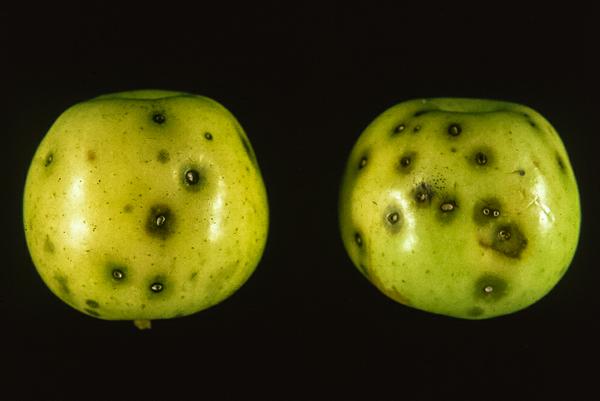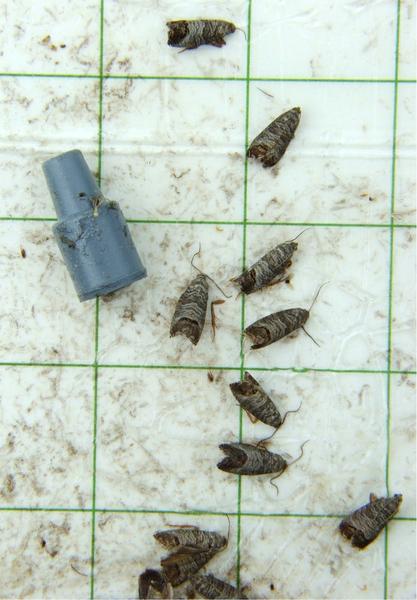Background and Description
The codling moth (Cydia pomonella; CM) is a tortricid moth originally native to Europe but now occurring in most parts of the world that have favorable habitat. In the mid-2000s it became a serious problem in many North Carolina orchards due to factors that included insecticide resistance and the practice of storing bins near orchards. (Apple bins are an ideal environment for overwintering larvae, and orchards within 100 to 150 yards (approximately 90 to 140 meters) of bins are particularly susceptible.) The use of mating disruption, new insecticides, and improved management practices have reduced the severity of CM damage, though CM, along with oriental fruit moth, remains one of the most significant lepidopterous apple pests in the region.
The adult CM is about 1/2 inch (12.5mm) long with gray striped wings that have patches of copper brown coloration at the tips. Both sexes have a similar appearance. The pupa is approximately 3/8 inch (9.5mm) long and brown. A fully developed larva is about 3/4 inch (19mm) long with a pinkish-beige body, brown head, and legs that are readily visible. CM larvae do not have the "anal comb" structure that is found on oriental fruit moth larvae when examined under a microscope. Eggs are about 1/25 inch (1mm) in diameter and are flat, white, and typically laid singly on both fruit and leaves.
Life History
CM overwinter as fully-developed larvae in thick cocoons under loose soil, dead leaves, or loose bark on the trunks of trees. In early spring, they change to the brown pupal stage, and by April or early May (depending on the year and location), they emerge as adult moths and begin mating. They lay eggs singly rather than in masses, and these generally begin to hatch near the time of the first cover spray. Larvae then tunnel into fruit, feeding and growing inside the apples. Larvae then leave the fruit and pupate on tree trunks, branches, and dead wood. The Southeast typically sees two generations per season, although a partial or complete third generation sometimes occurs.
Damage
The CM larvae usually tunnel into fruit directly, leaving holes containing frass (crumbly, brown excrement) that is visible on the exterior. Inside the fruit, they generally make a straight path to the core and sometimes feed on the seeds. This is in contrast to oriental fruit moth, which typically creates random tunnels as it feeds and usually does not attack the core. CM larvae may also cause "stings" on the surface of fruit if the larva is killed (by insecticides, for example) before it has a chance to penetrate inside.
Monitoring and Control
For detailed information on insect emergence times, degree-day calculations, and the most current control practices (including mating disruption and recommended insecticides), read the "Pest and Orchard Management Program," "IPM Practices for Selected Pests," and "Relative Effectiveness of Insecticides and Miticides" sections of the Integrated Orchard Management Guide for Commercial Apples in the Southeast.
First Generation: Recommendations are provided for low- and moderate-to-high population densities. Low-density orchards are those with less than 0.5 percent of fruit damaged the previous year and pheromone trap catches that do not exceed 10 moths per trap per week anytime during the first generation (to about 1,000 DD after biofix).
In low-density orchards, make a single insecticide application near 350 DD after biofix. In moderate-to high-density orchards, apply two insecticide applications at 14 to 21 days apart, the first at 100 to 250 DD after biofix: 100 to 150 if using a product which depends primarily on ovicidal activity for control (i.e., Intrepid or Rimon), and 250 if using an insecticide that targets early stage larvae. Additional applications may be necessary if trap captures remain high (greater than 7 moths per trap).
A second emergence of overwintering adults sometimes occurs between 500 and 800 degree days after biofix. This is often referred to as the “B peak” and may be associated with insecticide-resistant individuals in the population. Hence, pheromone trapping is important throughout the flight period.
Second Generation: Recommendations are provided for extremely low, low, and moderate-to-high population densities. Extremely low-density orchards may not require an insecticide application (no first-generation damage is observed and pheromone trap catches remain below one moth per trap per week between 1,000 and 2,500 DD after biofix). Low-density orchards require one insecticide application, and recent research indicates the optimum timing is 1,400 to 1,500 DD. These orchards may have no sign of damage by first generation larvae and trap catches between 3 to 7 moths per trap per week between 1,000 to 1,500 DD after biofix. Moderate-to high-density orchards will have fruit damage and higher pheromone trap catches requiring at least two insecticide applications at 14-day intervals, starting about 1,400 DD after biofix.
Third Generation: The model should not be relied upon alone for timing insecticide applications for the third generation, because the model becomes less accurate over time.
Exceptions to the Model: Where codling moth populations are extremely high and where pheromone trap catches remain high between generations, additional insecticide applications at shorter intervals may be necessary. This often occurs in orchards adjacent to abandoned orchards, orchards near bins, or in problem orchards with high populations.
Publication date: April 18, 2014
Recommendations for the use of agricultural chemicals are included in this publication as a convenience to the reader. The use of brand names and any mention or listing of commercial products or services in this publication does not imply endorsement by NC State University or N.C. A&T State University nor discrimination against similar products or services not mentioned. Individuals who use agricultural chemicals are responsible for ensuring that the intended use complies with current regulations and conforms to the product label. Be sure to obtain current information about usage regulations and examine a current product label before applying any chemical. For assistance, contact your local N.C. Cooperative Extension county center.
N.C. Cooperative Extension prohibits discrimination and harassment regardless of age, color, disability, family and marital status, gender identity, national origin, political beliefs, race, religion, sex (including pregnancy), sexual orientation and veteran status.


